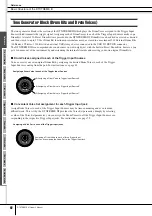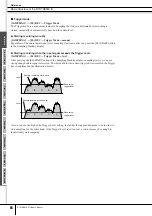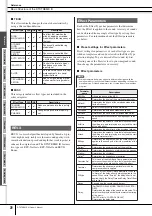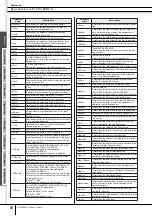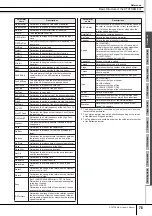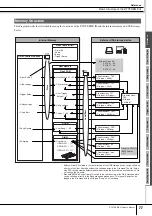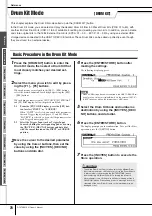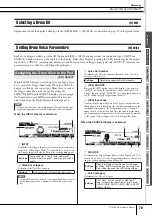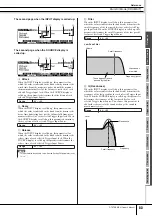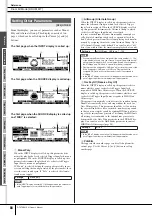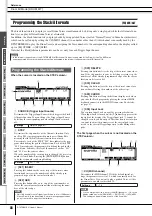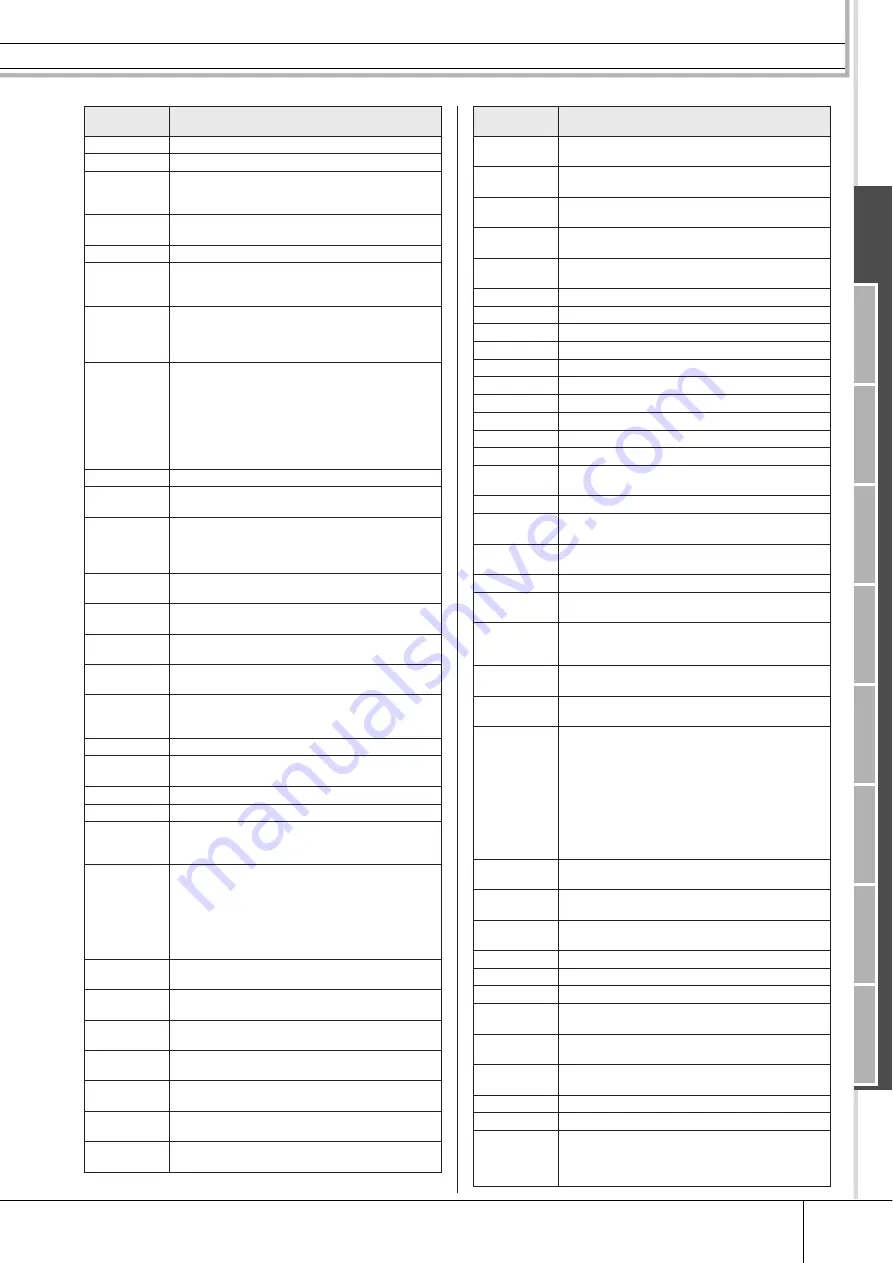
Basic Structure of the DTXTREME III
Reference
DTXTREME III Owner’s Manual
73
Dr
um Kit mode
Ref
erence
Song mode
Clic
k mode
Tr
igger mode
File mode
Utility mode
Chain mode
Sampling mode
DelayC
Determines the delay time for the center channel.
DelayL
Determines the delay time for the L channel.
DelayL>R
Determines the amount of time between the moment
the sound is input from the L channel and the
moment the sound is output to the R channel.
DelayOfstR
Determines the delay time for the R channel as off-
set.
DelayR
Determines the delay time for the R channel.
DelayR>L
Determines the amount of time between the moment
the sound is input from the R channel and the
moment the sound is output to the L channel.
Density
[For REVERB effects, except EARLY REFLECTION]
Determines the density of the reverberations.
[For EARLY REFLECTION]
Determines the density of the reflections.
Depth
[For FLANGER]
Determines the amplitude of the LFO wave which
controls the cyclic change of the delay modulation.
[For PHASER MONO, PHASER STEREO]
Determines the amplitude of the LFO wave which
controls the cyclic change of the phase modulation.
[For SPACE SIMULATOR]
Determines the depth of the simulated room.
Detune
Determines the amount of detuning of the pitch.
Device
Selects the device for changing how the sound is to
be distorted.
Diffuse
[For TEMPO PHASER, EARLY REFLECTION]
Determines the spread of the selected effect.
[For REVERB effects, except EARLY REFLECTION]
Determines the spread of the reverb.
Directn
Determines the direction of the modulation controlled
by the envelope follower.
Div.Lvl
Determines the minimum level of the portions
extracted via the slice effect.
DivFreqH
Determines the high frequency for dividing the entire
sound into three bands.
DivFreqL
Determines the low frequency for dividing the entire
sound into three bands.
DivideType
Determines how the sound (wave) is sliced by the
note length. This helps in setting rhythmic effects that
match the timing of the music.
DlyLvl
Determines the level of the delayed sound.
DlyLvlC
Determines the level of the delayed sound for the
center channel.
DlyMix
Determines the mixing level of the delayed sound.
DlyOfst
Determines the offset value of the delay modulation.
DlyTrnsit
Determines the speed (rate) at which the delay time
is changed from the current value to the specified
new value.
Drive
[For HARMONIC ENHANCER, TALKING MODULA-
TOR]
Determines the extent to which the enhancer or talk-
ing modulator is applied.
[For NOISY, SLICE]
Determines the degree and character of the distor-
tion effect.
DriveHorn
Determines the depth of the modulation generated
via the rotation of the horn.
DriveRotor
Determines the depth of the modulation generated
via the rotation of the rotor.
Dry/Wet
Determines the balance of the dry sound and effect
sound.
DryLPF
Determines the cutoff frequency of the low pass filter
applied to the dry sound.
DryLvl
Determines the level of the dry sound (the unproc-
essed sound).
DryMixLvl
Determines the level of the dry sound (the unproc-
essed sound).
DrySndNoise
Determines the level of the dry signal sent to the
noise effect.
Paramater
name
Descriptions
DyLvlOfs
Determines the offset value added to the output from
the envelope follower.
DyThreshLvl
Determines the minimum level at which the envelope.
follower starts.
Edge
Sets the curve that determines how the sound is dis-
torted.
Emphasi
Determines the change of the characteristics in high
frequencies.
EQ1Freq
Determines the Cutoff frequency of EQ1 (Low Shelv-
ing).
EQ1Gain
Determines the level gain of EQ 1 (Low Shelving).
EQ2Freq
Determines the center frequency of EQ2.
EQ2Gain
Determines the level gain of EQ2.
EQ2Q
Determines the Q of EQ2.
EQ3Freq
Determines the center frequency of EQ3.
EQ3Gain
Determines the level gain of EQ3.
EQ3Q
Determines the Q of EQ3.
EQ4Freq
Determines the center frequency of EQ4.
EQ4Gain
Determines the level gain of EQ4.
EQ4Q
Determines the Q of EQ4.
EQ5Freq
Determines the Cutoff frequency of EQ5 (High
Shelving).
EQ5Gain
Determines the level gain of EQ5 (High Shelving).
EQFreq
Determines the center frequency for each band of
the EQ.
EQGain
Determines the level gain of the EQ center frequency
for each band.
EQWidth
Determines the width of the EQ band.
ER/Rev
Determines the level balance of the early reflection
and reverb sound.
F/RDpth
This Auto Pan parameter (available when PAN Direc-
tion is set to “L turn” and “R turn”) determines the
depth of the F/R (front/rear) pan.
FBHiDmp
Determines how the high frequencies of the feedback
sound decay.
FBHiDmR
Determines the amount of decay in high frequencies
for the R channel as offset.
FBLevel
[For CHORUS effects, DELAY effects, TECH effects,
CLASSIC FLANGER, TEMPO FLANGER, DYNAMIC
FLANGER, COMP DISTORTION DELAY]
Determines the feedback level output from the delay
and returned to the input.
[For TEMPO PHASER, DYNAMIC PHASER]
Determines the feedback level output from the delay
and returned to the input.
[For REVERB effects]
Determines the feedback level of the initial delay.
FBLvl1
Determines the feedback level of the delayed sound
in the 1st series.
FBLvl2
Determines the feedback level of the delayed sound
in the 2nd series.
FBLvlR
Determines the feedback level for the R channel as
offset.
FBTime
Determines the delay time of the feedback.
FBTime1
Determines the delay time of feedback 1.
FBTime2
Determines the delay time of feedback 2.
FBTimeL
Determines the delay time of the feedback for the left
channel.
FBTimeR
Determines the delay time of the feedback for the
right channel.
Feedback
Determines the level of the sound signal output from
the effect block and returned to its own input.
Fine1
Determines the fine pitch setting for the 1st series.
Fine2
Determines the fine pitch setting for the 2nd series.
FltType
[For LO-FI]
Determines the type of tonal characteristics.
[For DYNAMIC FILTER]
Determines the filter type.
Paramater
name
Descriptions
Summary of Contents for DTXTREME III
Page 1: ...EN OWNER S MANUAL ...




